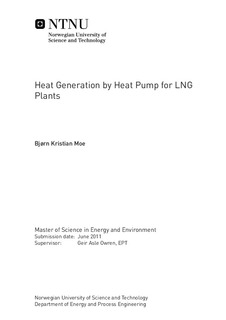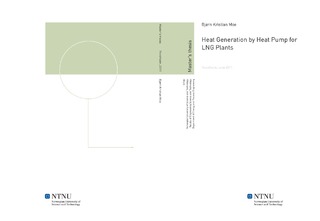| dc.description.abstract | Abstract The LNG production plant processing natural gas from the Snøhvit field outside Hammerfest in northern Norway utilizes heat and power produced locally with gas turbines. Building a new production train supplied with electricity from the power grid is being evaluated as a possible solution for reducing CO2 emissions from the plant. Buying electricity from the grid rather than producing it in a combined heat and power plant makes it necessary to find new ways to cover the heat loads at the production plant. A project thesis was written in the fall semester 2010 evaluating the possibility of generating the necessary heat with heat pumps. It was concluded that parts of the required heat could be delivered with reasonable efficiencies using heat pumps. Further, a heat pump delivering heat to the CO2-removal system was analyzed. Simulations showed that the required heat load, reaching approximately 62 MW at full production, could be delivered from a heat pump using butane as working fluid. The electrical power consumption for the compressors would be 23.3 MW, giving the heat pump a COP of 2.66. In this master thesis the heat pump suggested earlier is analyzed, focusing on identifying losses. Several possible changes that will enhance the heat pump’s efficiency are suggested. The use of other workings fluids and mixed refrigerants are analyzed as well, using the process simulation software Pro/II. The simulations indicates that the heat pump should be equipped with a flash tank at middle pressure, thereby reducing throttling losses and required mass flows through the evaporators. In addition, the suction gas should be overheated as much as possible. Using mixed refrigerants lowers the efficiency of the heat pump. Finally, two new systems are suggested: One with butane as workings fluid and one with pentane, both with flash tank at middle pressure and superheated suction gas. The pentane-system gives the highest system COP, but requires much bigger compressors than the butane-system. The table shows the most important results. Working fluid Electrical power consumption [MW] Volume flow suction gas [m3/h] COP Butane (C4H10) 18.6 55000 3.35 Pentane (C5H12) 17.5 150000 3.54 The power grid electricity is assumed to have been produced without any CO2 emissions. Covering the heat required by the CO2 removal system with a gas fired furnace would generate CO2 emissions of approximately 120,000 tons per year. Heat pumps are a good solution because they deliver relatively cheap heat without these CO2 emissions. | nb_NO |

